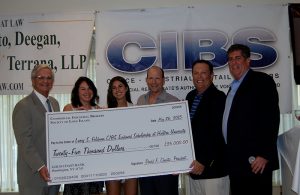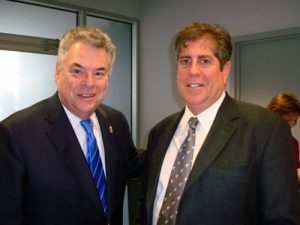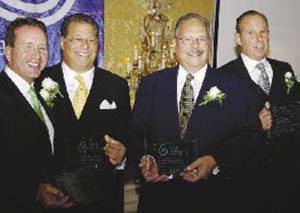
Organization of the Month: The Commercial and Industrial Brokers Society of Long Island (CIBS) celebrates its 25th anniversary
Melville, NY Born out of adversity in 1991 to bring together some of the most competitive real estate brokerage businesses on Long Island, the Commercial and Industrial Brokers Society of Long Island (CIBS) has evolved over 25 years into one of the most respected business organizations in the bi-county region.
Today, with membership in the hundreds, CIBS is providing networking venues for brokers and those in related businesses, educational programs for new brokers, philanthropy for area charities and it’s been recognized as one of Long Island’s leading business organizations by elected officials on Long Island, Albany and in Washington, D.C.
CIBS founding goes back to the early 1990s, when the region’s economy was in the depths of recession and a tight market that reduced brokers’ incomes and intensified competition for deals.
Not much earlier, the region’s developers and landlords had banded together as the Association for a Better Long Island (ABLI).
In 1991, Syosset developer Edward Blumenfeld, of Blumenfeld Development Group, then the ABLI president, called together four industry leaders: Herb Agin of Sutton & Edwards, Paul Amoruso of Oxford & Simpson, Joseph Lagano Sr., who then headed the Long Island office of Cushman & Wakefield, and Samuel Rozzi, president of Corporate National Realty.
“How come you guys have no organization?” Blumenfeld recalled asking the brokers.
The reasons may have been obvious.
“The brokerage community was very fractious,” said co-founder Herb Agin, now chief executive of Colliers International Long Island. “Landlords and tenants didn’t look at commercial real estate brokers with any high level of esteem.”
Blumenfeld recalled telling the four powerful brokers that developers thought the Island could be better served by a commercial brokerage industry that spoke with one voice. They felt that the Long Island Board of Realtors, focused on residential real estate, did not represent their interests.
“It was time,” said Amoruso. “It was a voice that was needed for some time.”
But it wasn’t easy getting competitors to work together, brokers recalled. “We were all very nervous,” Agin said.
Nevertheless, after months of meetings, CIBS officially came into existence in January 1992 and soon after the new organization attracted more than 140 brokers to its first meeting, a dinner at the Milleridge Cottage in Jericho.
Today, membership, which has expanded and contracted over the years with the economic cycles, now hovers around 300 and accounts for almost two-thirds of all commercial brokers on Long Island.
 CIBS check presentation in 2014 for Hofstra University scholarship honoring the late general counsel Larry Feldman.
CIBS check presentation in 2014 for Hofstra University scholarship honoring the late general counsel Larry Feldman.“It’s evolved as a cohesive group in an industry in which we compete with each other,” said Amoruso, adding that CIBS has become a voice for promoting Long Island at a time when others, among them the former Long Island Lighting Co. and Roy Cacciatore, the late Hempstead Town economic development commissioner, disappeared.
In recent years, CIBS’ leaders worked to make membership more desirable, offering educational programs, a dispute-resolution mechanism and, albeit briefly, an online database of available properties.
As membership grew, CIBS became a forum for brokers to handle their problems. Brokers who came to networking events, such as the annual black-tie dinner held together with the ABLI in the spring, found it easier to resolve problems by calling each other. “The communication took away some of the fear of dealing with each other,” Chuck Tabone, a former CIBS president said during his term.
In 2013, CIBS began to project its voice, adding the position of strategic officer to its leadership ranks to enable a more active role in the community, form alliances with other business groups, provide CIBS’ perspective on local issues and make the organization more visible. David Pannetta, twice president of CIBS, took on the role.
CIBS’ educational programs also have changed out of necessity. The days of getting someone in a car and saying, “Here are some buildings,” wasn’t enough. Brokers needed to be more financially savvy.
Because of those changes, CIBS’ educational programs had taken on more significance. They also helped generate camaraderie within the industry, which in turn, promoted friendlier deal making.
Golf, meanwhile, also had become an integral part of CIBS’ program, beginning in 1996 with the first annual golf outing at the Hempstead Country Club, a fundraiser for Ronald McDonald House of Long Island. Largely as a result of the efforts over the years of John Ruffa, of NAI Long Island, the golf outing sells out annually and has raised funds for many charities, among them Big Brothers & Big Sisters, a Hofstra University scholarship honoring founding general counsel Larry Feldman, the March of Dimes, the Center for Developmental Disabilities, Independent Group Home Living Program, the Interfaith Nutrition Network, the League for Animal Protection and the American Cancer Society.
In recent years, CIBS breakfast programs, through the efforts of current president David Chinitz brought headline making guest speakers before the group, including senator Charles Schumer, county executives Steve Levy and Edward Mangano, representatives Peter King and Kathleen Rice, former state senate majority leader Dean Skelos and a host of others. The programs, including panel discussions featuring leading brokers, landlords and lawyers, have garnered both print and television media attention. “Our events have remained fresh, fun and invaluable for networking,” said Chinitz.
Additionally CIBS now recognizes ndustry rising stars and highly involved associates members with annual awards.
Newer programs, geared to the industry’s younger members and dubbed CIBS Future Generation, has brought together novices and experienced brokers in unique social settings.
Also, CIBS’ leaders committed to boosting awareness of the group and promoting the brokerage industry as well as Long Island business by undertaking advertising, public relations and social media efforts.
Now, a quarter of a century after CIBS’ founding, Blumenfeld looking back at CIBS’ accomplishments said. “It’s been beneficial for everybody.”


